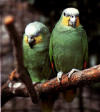Parrots Housed in Pairs Fair Better than Singles, research shows
Friday, January 23 2004 @ 08:22 PM UTC
Contributed by: MikeSchindlinger
 It has been suggested that isolation from conspecifics may contribute to the development of abnormal behaviors that are common in captive parrots, including stereotypy, feather plucking, excessive fearfulness and aggression. Thus, we assessed the influence of isosexual pair housing on the development of these behaviors, as well as the incidence of illness and injury, in young Orange-winged Amazon parrots (Amazona amazonica).
It has been suggested that isolation from conspecifics may contribute to the development of abnormal behaviors that are common in captive parrots, including stereotypy, feather plucking, excessive fearfulness and aggression. Thus, we assessed the influence of isosexual pair housing on the development of these behaviors, as well as the incidence of illness and injury, in young Orange-winged Amazon parrots (Amazona amazonica).
Isosexual pair housing improves the welfare of young Amazon parrots
Meehan CL, Garner JP, Mench JA
APPLIED ANIMAL BEHAVIOUR SCIENCE
81 (1): 73-88 MAR 20 2003
Abstract:
It has been suggested that isolation from conspecifics may contribute to the development of abnormal behaviors that are common in captive parrots, including stereotypy, feather plucking, excessive fearfulness and aggression (e.g. [Proceedings of the European Symposium on Bird Diseases, Beerse, Belgium (1987), p. 98; Kleintierpraxis 3 8 (1993) 511]). Thus, we assessed the influence of isosexual pair housing on the development of these behaviors, as well as the incidence of illness and injury, in young Orange-winged Amazon parrots (Amazona amazonica).
Parrots (n = 21) were parent raised to 6 months of age and then housed either singly or in isosexual pairs. All cages included inanimate enrichments that were changed regularly, and all parrots were handled regularly. Behavioral activity was recorded 0,3,6,9 and 12 months after the parrots were housed in the experimental cages, and responses (e.g. willingness to approach, tolerance to touch, flight distance) to familiar and strange human handlers and to novel objects introduced into the home cage were recorded periodically. Paired parrots used their enrichments more (GLM: F-1,F-10 = 13.74; P = 0.004), and spent less time screaming (F-1,F-10 = 4.90; P = 0.051), less time preening (F-1,F-10 = 5.12; P = 0.047), and less time inactive (F-1,F-10 = 9.24; P < 0.012) than singly housed parrots. Time spent climbing, walking and flying decreased in both groups during the study, but the decrease was greater in the singly housed parrots (F-1,F-54 = 4.50; P = 0.038). None of the paired parrots developed stereotypy by month 12, while 57% of the singly housed parrots did.
Responses to familiar handlers did not differ, but paired parrots responded increasingly significantly less fearfully and aggressively to unfamiliar handlers during the study than did singly housed parrots (F-1,F-54 = 6.37;P = 0.015). Latency to approach novel objects was significantly reduced in the paired group when the two birds were tested together (F-2,F-15 = 7.69; P = 0.005). No parrots in the single group sustained injuries while 21% of the parrots in the paired condition experienced injuries, although none of these could be directly linked to intra-pair aggression. Rates of illness did not differ between the two groups.
Isosexual pair housing resulted in a more active and diverse behavioral repertoire, eliminated the development of stereotypy and reduced fear responses to novel objects without imparting significant risk of illness and injury or jeopardizing the ability of parrots to relate positively with humans.
Thus, it appears that pair housing can significantly improve environmental quality and positively affect the welfare of captive parrots.
(C) 2002 Elsevier Science B.V. All rights reserved.
Author Keywords:
parrots, psittacine, environmental enrichment, welfare, social housing
KeyWords Plus:
ENVIRONMENTAL ENRICHMENT, DOMESTIC CHICKS, BEHAVIOR, MONKEYS, FEAR, RAT
Addresses:
Mench JA, Univ Calif Davis, Dept Anim Sci, Anim Behav Grad Grp, Davis, CA 95616 USA
Univ Calif Davis, Dept Anim Sci, Anim Behav Grad Grp, Davis, CA 95616 USA
Publisher:
ELSEVIER SCIENCE BV, PO BOX 211, 1000 AE AMSTERDAM, NETHERLANDS
IDS Number:
645RF
ISSN:
0168-1591
0 comments
http://www.freeparrots.net/article.php?story=20031221082244504
 It has been suggested that isolation from conspecifics may contribute to the development of abnormal behaviors that are common in captive parrots, including stereotypy, feather plucking, excessive fearfulness and aggression. Thus, we assessed the influence of isosexual pair housing on the development of these behaviors, as well as the incidence of illness and injury, in young Orange-winged Amazon parrots (Amazona amazonica).
It has been suggested that isolation from conspecifics may contribute to the development of abnormal behaviors that are common in captive parrots, including stereotypy, feather plucking, excessive fearfulness and aggression. Thus, we assessed the influence of isosexual pair housing on the development of these behaviors, as well as the incidence of illness and injury, in young Orange-winged Amazon parrots (Amazona amazonica).